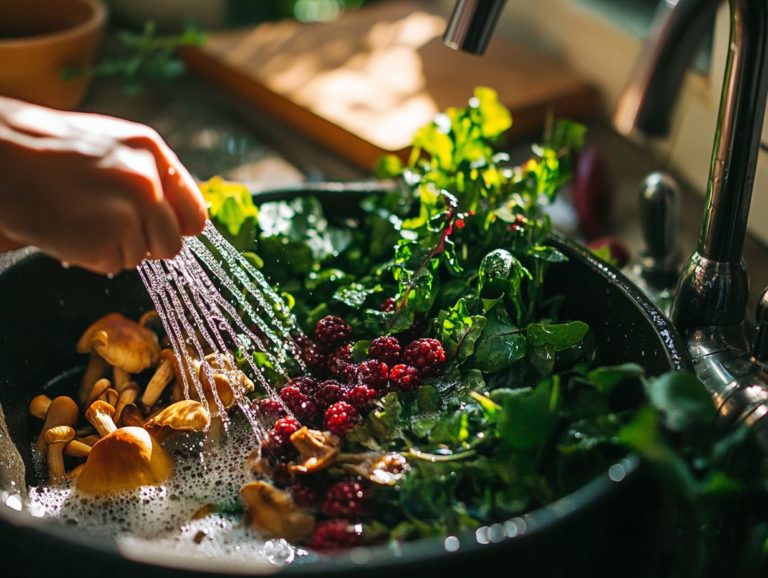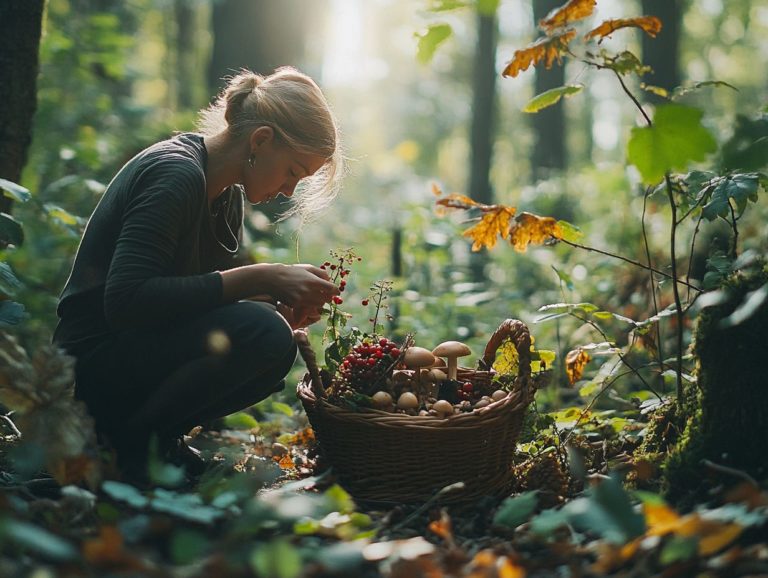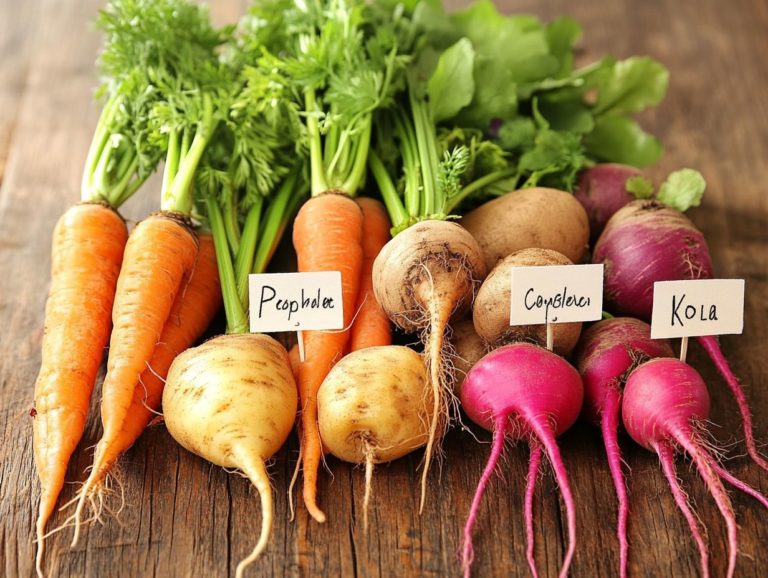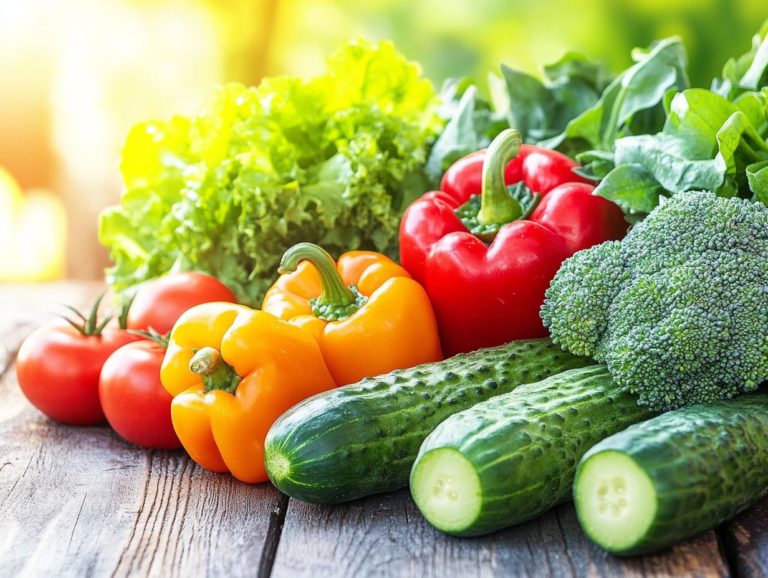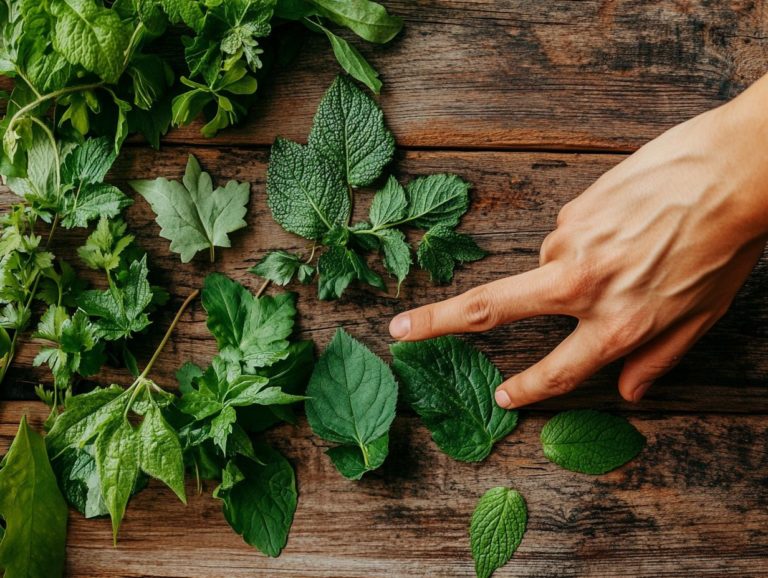How to Use Foraged Ingredients in Cooking?
Foraged ingredients are nature s hidden gems, offering rich flavors and unique nutritional benefits that elevate your everyday cooking. Don t miss out on the chance to discover these incredible ingredients! From wild herbs to edible flowers, these treasures have the power to transform your dishes and deepen your connection to the environment.
This article delves into the myriad advantages of using foraged ingredients, sharing essential tips on how to identify and source them safely. You’ll also find practical advice on preparing and incorporating these delightful finds into your meals. Key safety considerations will be highlighted to ensure that your foraging adventures are not only delicious but also safe. Whether you’re a seasoned forager or simply intrigued, there s something here for you to explore!
Contents
- Key Takeaways:
- Benefits of Using Foraged Ingredients in Cooking
- Identifying and Sourcing Foraged Ingredients
- Preparing and Cooking with Foraged Ingredients
- Safety Considerations for Foraged Ingredients
- Tips for Successful Foraging and Cooking
- Frequently Asked Questions
- What are foraged ingredients and why should I use them in cooking?
- How do I know which foraged ingredients are safe to eat?
- Can I use foraged ingredients in any recipe?
- Do I need to prepare foraged ingredients differently than store-bought ingredients?
- What are some popular foraged ingredients that I can use in cooking?
- Are there any ethical considerations when foraging for ingredients?
Key Takeaways:
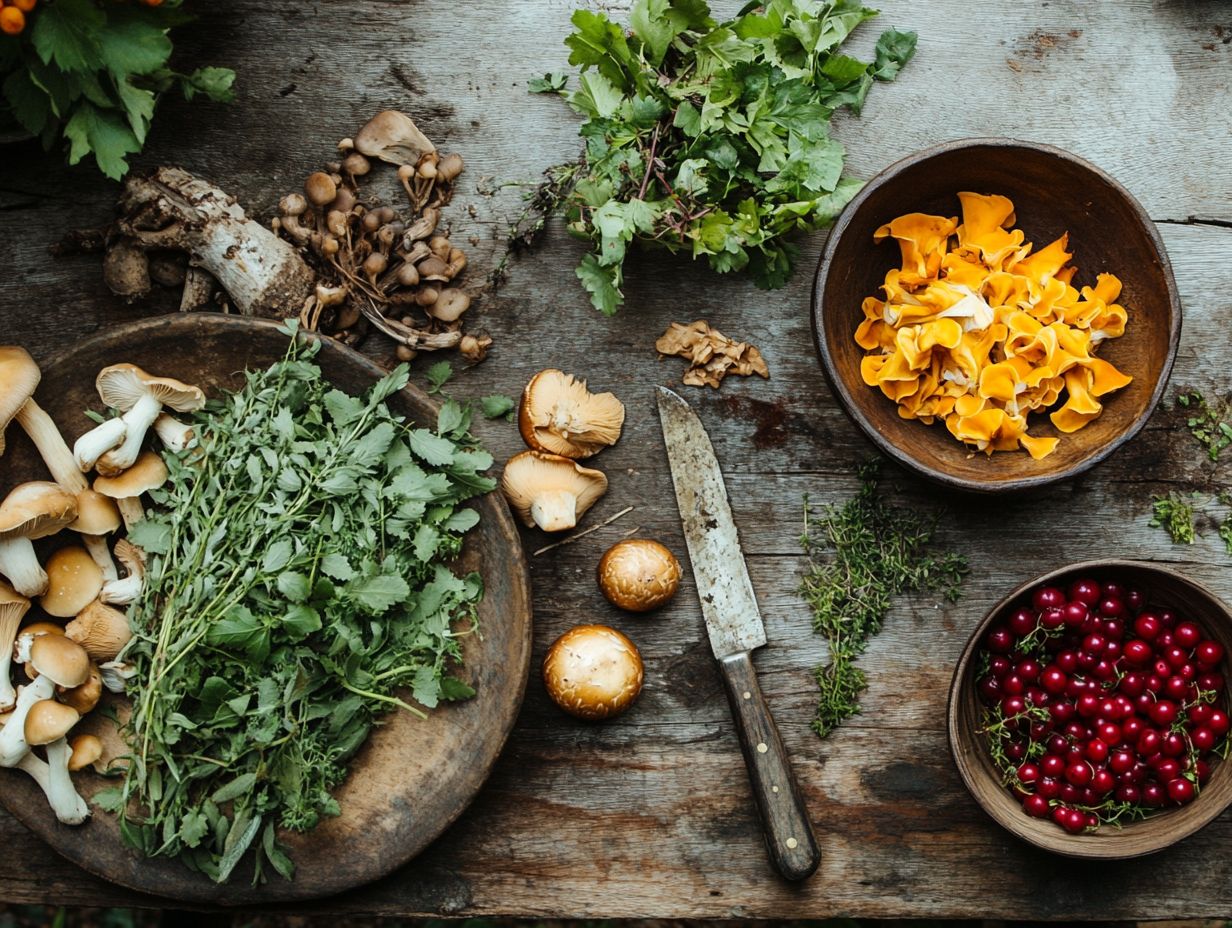
- Foraged ingredients offer unique and flavorful additions to your cooking while also providing nutritional benefits.
- It is important to properly identify and source foraged ingredients from safe and sustainable locations to ensure their safety.
- To safely incorporate foraged ingredients into your cooking, make sure to clean and store them properly and get creative with incorporating them into recipes.
What are Foraged Ingredients?
Foraged ingredients offer a captivating array of naturally occurring edible plants, wild mushrooms, herbs, and vegetables that you can source right from their natural habitats. These unique finds, like wild asparagus and edible flowers, not only elevate your cooking creativity but also have profound ties to local food cultures. To explore the most popular foraging recipes, you can champion sustainable cooking practices, which means cooking in ways that are good for the environment.
By embracing foraged food, you can delve into the exciting realm of nature’s pantry, elegantly bridging traditional recipes with modern techniques. Foraged items offer diverse textures and flavors. Imagine the earthy richness of chanterelle mushrooms or the peppery zing of wild nasturtium leaves. To learn more about incorporating these unique ingredients, check out how to use foraging techniques in cooking. These elements will undoubtedly enhance countless dishes, inspiring you to adapt recipes that celebrate the bounty each season brings.
Through foraging, you cultivate a deeper appreciation for local ecosystems and honor the traditions of your community, often unearthing forgotten recipes that highlight these natural treasures. This connection to nature and heritage encourages a more mindful approach to food, nurturing a sustainable relationship with the land.
Benefits of Using Foraged Ingredients in Cooking
Integrating foraged ingredients into your cooking opens up a world of benefits, from elevated flavor profiles to impressive nutritional advantages. For more insights, consider mastering the art of wild foraging techniques, which also fosters a deeper connection to seasonal ingredients and local food cultures.
Foraged foods often bring unparalleled freshness and distinctive flavors that outshine their store-bought counterparts, aligning perfectly with sustainable cooking practices.
By embracing the art of foraging, you can craft dishes that not only highlight the natural flavors of your surroundings but also encourage healthy eating habits and support local ecosystems. It’s a culinary adventure that enriches both your plate and your community.
Nutritional Value and Flavor
The nutritional value of foraged food can be truly remarkable. Imagine discovering wild ingredients like mushrooms, herbs, and greens that provide essential vitamins, minerals, and antioxidants to support your overall health. These ingredients not only contribute to a well-balanced diet but also deliver natural flavors that are often more vibrant than their cultivated counterparts.
This rich diversity enables you to enhance your dishes while embracing the unique characteristics of each foraged ingredient, fostering a deeper appreciation for culinary exploration.
Take wild chanterelles, for example. They re not just a delicious addition to your meals; they also pack a substantial amount of B vitamins and vitamin D. Then there are stinging nettles, frequently overlooked but loaded with iron, perfect for soups or teas. They bring a distinctive herbal flavor that elevates any recipe.
Dandelion greens add a touch of bitterness to salads while being rich in antioxidants. Each of these ingredients not only supports your health but also sparks creativity in the kitchen, allowing you to explore new flavor profiles that celebrate nature s bounty.
Identifying and Sourcing Foraged Ingredients
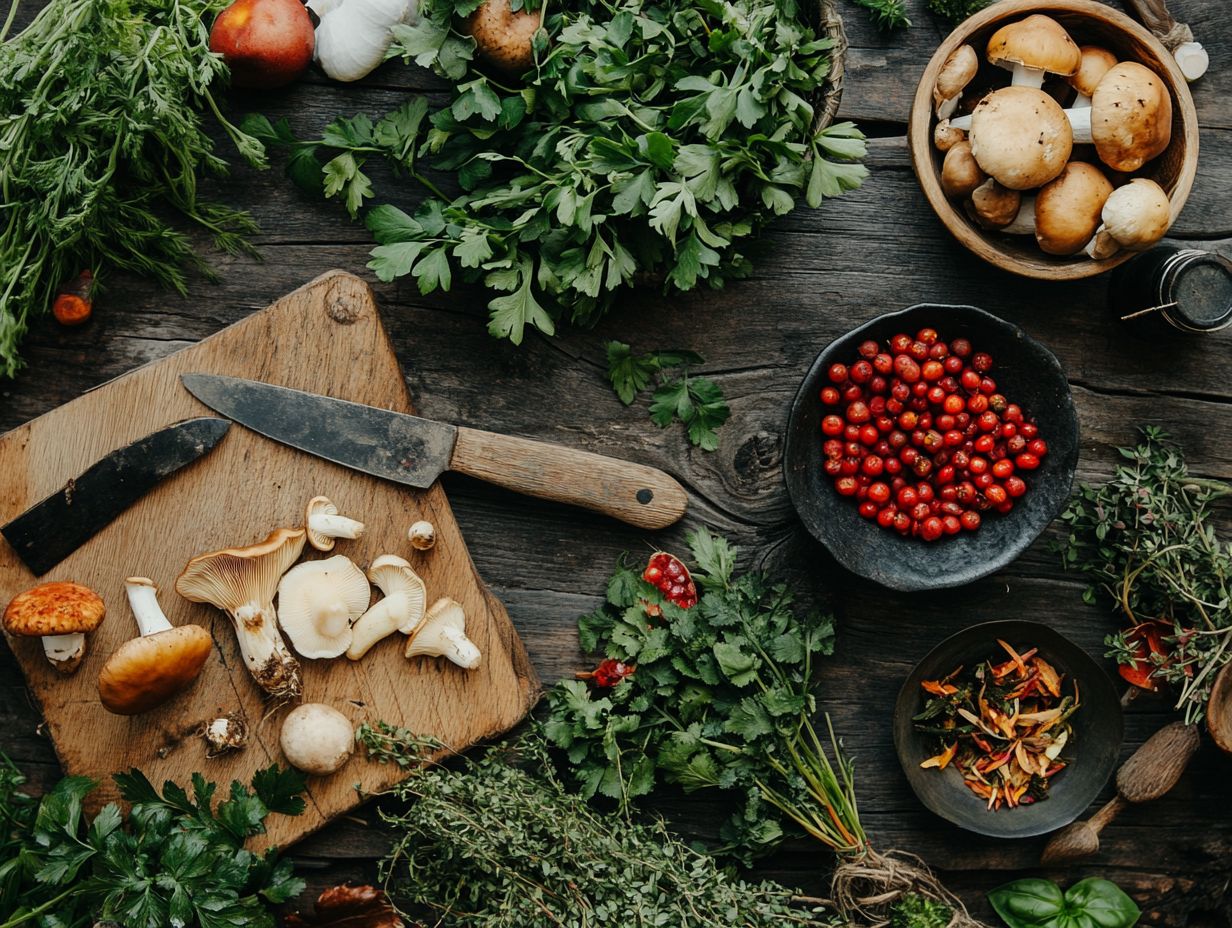
Identifying and sourcing foraged ingredients demands a deep understanding of local ecosystems, where you can find a treasure trove of edible plants, wild mushrooms, and seasonal delights. Familiarity with foraging techniques is essential, particularly when it comes to identifying mushrooms and recognizing safe, edible flowers.
Mastering these skills elevates your cooking and cultivates a responsible and sustainable relationship with the natural world around you.
Where to Find and How to Identify Safe Foraged Ingredients
Locating and identifying safe foraged ingredients entails exploring a rich tapestry of habitats think forests, fields, and wetlands where you’ll be thrilled to discover an array of wild plants, mushrooms, and seasonal delights. You ll want to familiarize yourself with the characteristics of edible flowers and the key signs for safely identifying mushrooms.
By honing these skills, you’ll confidently gather exciting ingredients while minimizing the risks often associated with foraging!
During a leisurely stroll through a lush woodland, you might find wild garlic, easily recognized by its strong, pungent aroma and large green leaves. In fields bursting with dandelions, you ll discover both nutritious leaves and bright yellow blossoms, all entirely edible.
Identifying safe mushroom varieties like chanterelles or morels requires keen attention to detail. Knowing the specific shapes, colors, and preferred habitats helps you steer clear of toxic impostors.
Following proper foraging etiquette helps foster a deep respect for nature, allowing you to revel in a bounty of wild flavors without compromising the ecosystems that yield them.
Preparing and Cooking with Foraged Ingredients
Preparing and cooking with foraged ingredients requires a careful approach to cleaning, storing, and integrating ingredients such as wild mushrooms and edible plants into recipes. By learning how to use foraging in culinary arts, employing proper cleaning methods allows the natural flavors of your foraged treasures to shine, while effective storage techniques maintain their freshness for extended periods.
By mastering culinary methods tailored to seasonal cooking, you can elevate your experience with these wild ingredients, transforming them into unique and exquisite dishes that delight the palate.
Cleaning, Storing, and Incorporating into Recipes
Cleaning foraged ingredients, like wild mushrooms and edible plants, demands your careful attention to detail. You want to preserve those natural flavors while ensuring any dirt or debris is thoroughly removed.
You need proper storage techniques to maintain the freshness and quality of your finds, allowing you to seamlessly incorporate them into a diverse array of recipes. When you apply effective cooking methods, you can transform foraged foods into exquisite dishes that showcase their unique characteristics and seasonal charm.
When you go foraging, use a soft brush to clean mushrooms thoroughly and rinse leafy greens in cool water. This will help eliminate any grit without causing damage. For longer storage, consider drying mushrooms or blanching and freezing greens both methods effectively lock in delightful flavors.
These carefully prepared ingredients can elevate your culinary creations, whether it s a creamy wild mushroom risotto or a vibrant salad adorned with foraged herbs. Saut ing the mushrooms with garlic enhances their earthy tones beautifully. Techniques like roasting or pickling can further amplify these flavors, ensuring a delightful experience in every bite.
Get out there and start foraging delicious adventures await!
Safety Considerations for Foraged Ingredients
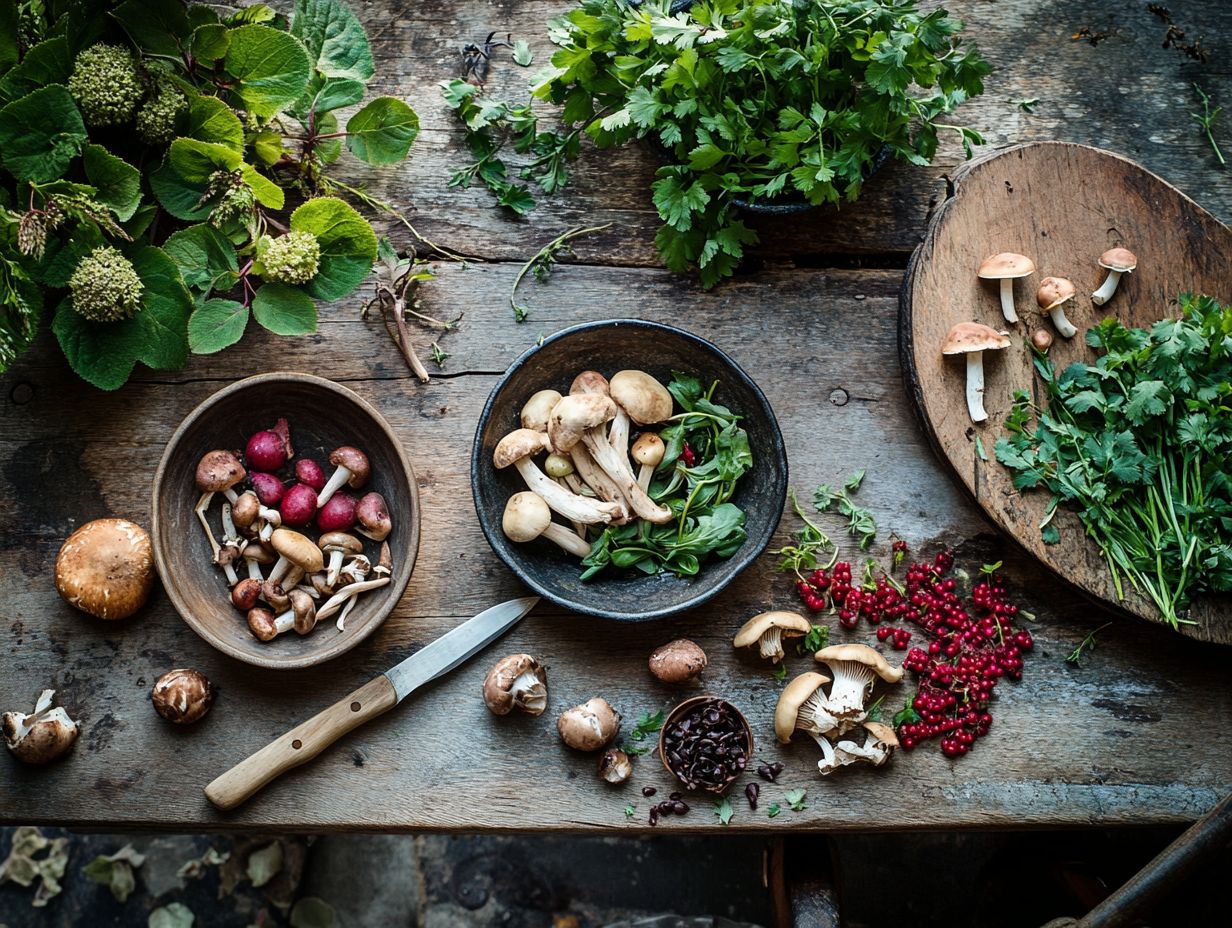
Safety considerations when foraging for ingredients are essential. The risks tied to misidentifying wild plants and mushrooms can have serious health repercussions. It’s crucial for you to learn how to accurately identify mushrooms and recognize which foraged foods are safe to consume.
Take action now by consulting reliable guides and joining foraging groups for a safe adventure!
Potential Risks and Precautions
Engaging in the practice of foraging for wild mushrooms and edible plants comes with risks that you can’t afford to overlook. A solid understanding of safety precautions is essential.
Recognizing the signs of toxic species and honing your skills in accurately identifying mushrooms are crucial abilities every forager should cultivate.
Misidentifying mushrooms can seriously harm your health. Be careful and always double-check!
Stay updated on local plants and possible toxicities. Always start with small quantities of any new edible species to monitor for adverse reactions and ensure safe consumption. Your safety and enjoyment depend on it.
Tips for Successful Foraging and Cooking
Successful foraging and cooking with wild ingredients relies on effective tips and best practices that enable you to delve into the vibrant world of wild food culture.
By grasping the nuances of seasonal cooking and the importance of local ingredients, you can elevate your cooking creativity, turning nature s bounty into extraordinary dishes.
Embracing these strategies not only enhances your cooking experience but also nurtures a deeper appreciation for nature.
Best Practices and Creative Ideas
Incorporating best practices into foraging and cooking opens the door to exciting cooking creativity, enabling you to make the most of seasonal ingredients.
By emphasizing the use of fresh, foraged foods, you can explore unique recipes that highlight wild mushrooms, edible plants, and herbs.
With a touch of innovative cooking techniques, you can elevate your dishes while embracing a sustainable approach to sourcing ingredients.
For instance, why not craft a vibrant salad featuring dandelion greens and wild violets? It brings both color and nutrition to your table.
If foraging is your passion, consider experimenting with infused oils using freshly gathered herbs like garlic mustard or wild garlic. These distinctive flavors can elevate your dressings and marinades to new heights.
Recognizing the ethics of foraging such as accurately identifying plants and respecting nature s balance enriches not only the flavor but also the storytelling behind each dish. This way, every meal becomes an adventure in sustainability and taste.
Frequently Asked Questions
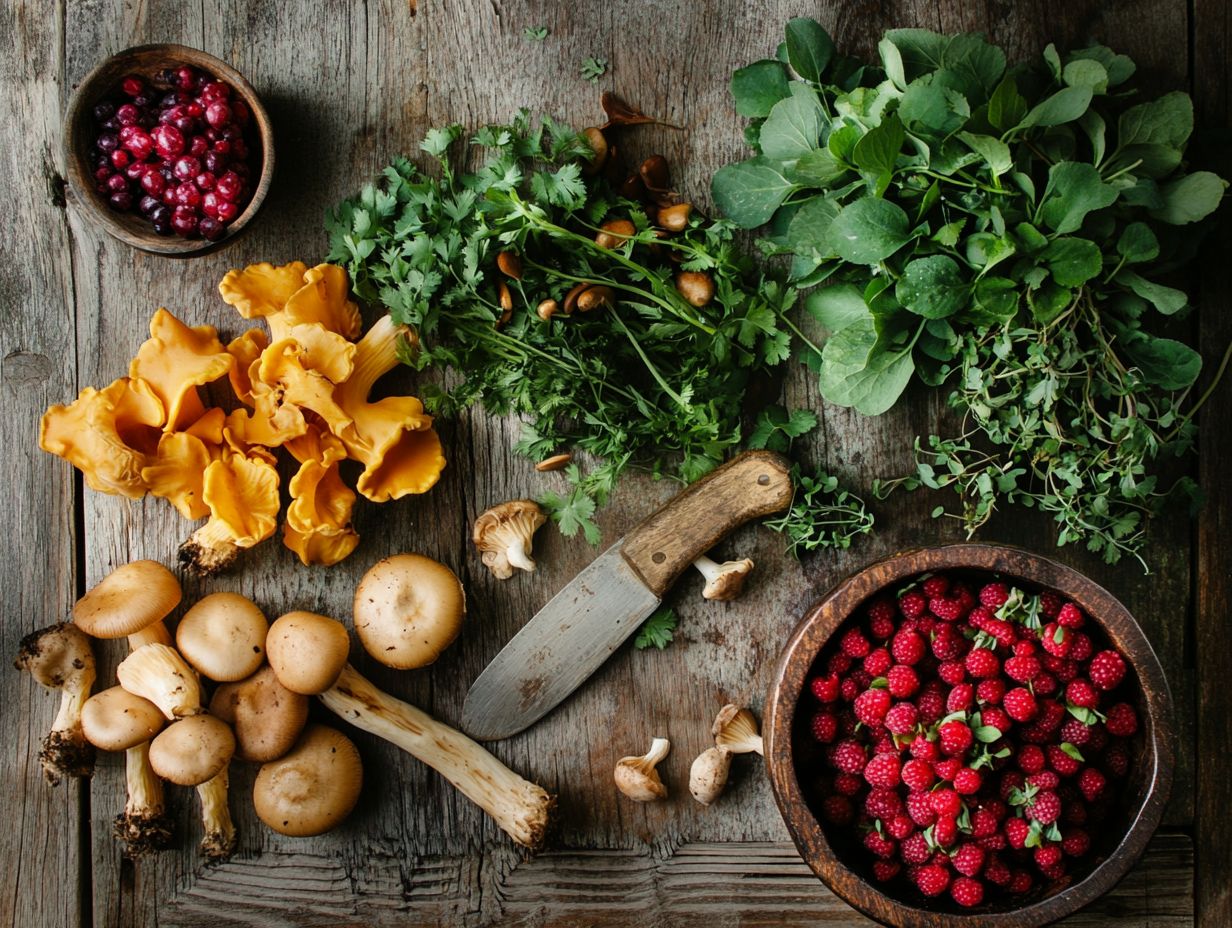
What are foraged ingredients and why should I use them in cooking?
Foraged ingredients come straight from nature, like wild berries, mushrooms, and herbs. They bring unique flavors that can spice up your meals, especially when you know how to use local resources for sustainable foraging.
How do I know which foraged ingredients are safe to eat?
It is important to properly identify foraged ingredients before consuming them. It is best to consult with an expert or do thorough research to ensure they are safe for consumption.
Join our foraging community or subscribe for more tips to enhance your experience!
Can I use foraged ingredients in any recipe?
Absolutely! Foraged ingredients can transform your meals, whether in salads, soups, or desserts.
Just make sure to choose the right ingredient to complement the dish.
Do I need to prepare foraged ingredients differently than store-bought ingredients?
Foraged ingredients often need extra cleaning.
Always wash them thoroughly to make sure they re safe to eat.
What are some popular foraged ingredients that I can use in cooking?
Popular foraged ingredients like wild garlic and chanterelle mushrooms add unique flavors.
They re perfect for elevating your dishes!
Are there any ethical considerations when foraging for ingredients?
Yes! Forage responsibly.
Only take what you need and avoid endangered species.


